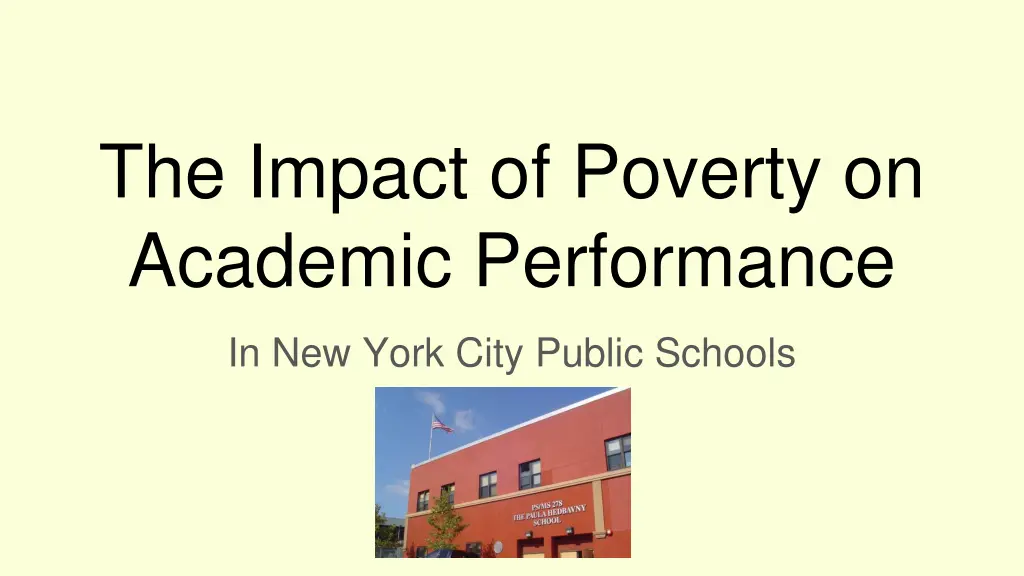
Impact of Poverty on Academic Performance in NYC Schools
Explore the impact of poverty on academic performance in New York City public schools, focusing on the challenges faced by students living in low-income areas. Learn how poverty affects test scores, student proficiency rates, and potential reasons behind these disparities. Discover the definition of poverty, the evidence gathered from recent student data, and external factors influencing a parent's ability to provide for their children.
Uploaded on | 1 Views
Download Presentation

Please find below an Image/Link to download the presentation.
The content on the website is provided AS IS for your information and personal use only. It may not be sold, licensed, or shared on other websites without obtaining consent from the author. If you encounter any issues during the download, it is possible that the publisher has removed the file from their server.
You are allowed to download the files provided on this website for personal or commercial use, subject to the condition that they are used lawfully. All files are the property of their respective owners.
The content on the website is provided AS IS for your information and personal use only. It may not be sold, licensed, or shared on other websites without obtaining consent from the author.
E N D
Presentation Transcript
The Impact of Poverty on Academic Performance In New York City Public Schools Insert picture.
Step 1: Define The Problem Many New York Students struggle everyday with poverty. https://nypost.com/2018/10/29/poverty-rate-soars-among-nyc-schoolskids/ https://www.nytimes.com/2008/11/24/nyregion/24children.html About 74 percent of the total student population (839,705) qualify for free or reduced price lunches. This is a common poverty marker.
Public Housing -- Low Income Affects Test Scores About 112,000 children ages 5 to 18 live in buildings managed by the city s public housing agency, the New York City Housing Authority. The agency, the city s biggest landlord, maintains 178,000 apartments, providing low-rent housing subsidized by the federal government to low- and moderate-income families. The study is based on city public schools data from the 2002-3 academic year, including student demographics and test scores as well as teacher and school characteristics. It does not provide a definitive reason why the two types of students perform so differently, but it offers possible explanations. The researchers suggest that public housing s culture of poverty offers young people few role models to stress the importance of education, limits their resources and exposes them to crime or widespread peer pressure from those not doing well in school. Another possible reason is that families who live in public housing may differ from other poor families in ways that are hard to measure. - From the New York Times
Step 2: Gather the evidence The 2018-2019 results for NYC students living in low-income areas were: In English, the overall percentage of New York City students meeting the State s bar for proficiency increased by 0.7 percentage points, from 46.7 percent to 47.4 percent. In Math, the overall percentage of proficient students in New York City increased by 2.9 percentage points, from 42.7 percent to 45.6 percent.
What is considered poverty? Poverty is lack of shelter. Poverty is being sick and not being able to see a doctor. ... This poverty definition encompasses living conditions, an inability to meet basic needs because food, clean drinking water, proper sanitation, education, health care and other social services are inaccessible.
What external factors cause poverty? Brainstorm with your group. What are 1-3 external factors that might impact a parent s ability to provide substantially with respect to living conditions/housing) and providing food? You will be sharing our. External circumstances that affect living on or below the poverty level. Circumstance 1 Circumstance 2 Circumstance 3
Step 4: Evaluate an existing policy What supports are in place in New York City to help support students living at or below the poverty level. EXISTING SYSTEMS: Support 1 Support 2 Support 3
Step 5: Develop solutions Brainstorm with your group. What is a solution in New York City to help students at or below the poverty level to reach a better quality of life (food/shelter)? Come up with 1 to 3 ideas. POSSIBLE SOLUTIONS: Solution 1 Solution 2 Solution 3
Step 6: Select the best solution Based on the three policy solutions you developed in the previous step, we now need to examine how effective each is at children getting off the poverty level. Then we will determine how feasible each of the three solutions are. Feasibility refers to how likely it is that the solution will be implemented. Cost, time and legality are all factors that determine the feasibility of a policy solution. E F F E C T I V E N E S S FEASIBILITY High Medium Low High Medium Low
Conclusion: Key Take-Away 1) Getting away from poverty is SO IMPORTANT . Help out those in need; even just a little. 1) The 6-step PPA process (define the problem, gather the evidence, identify the causes, evaluate existing policies, develop solutions, choose the best solution) can be used to tackle MANY economic and social problems! THE COMMUNITY AND YOU are part of the solution!
